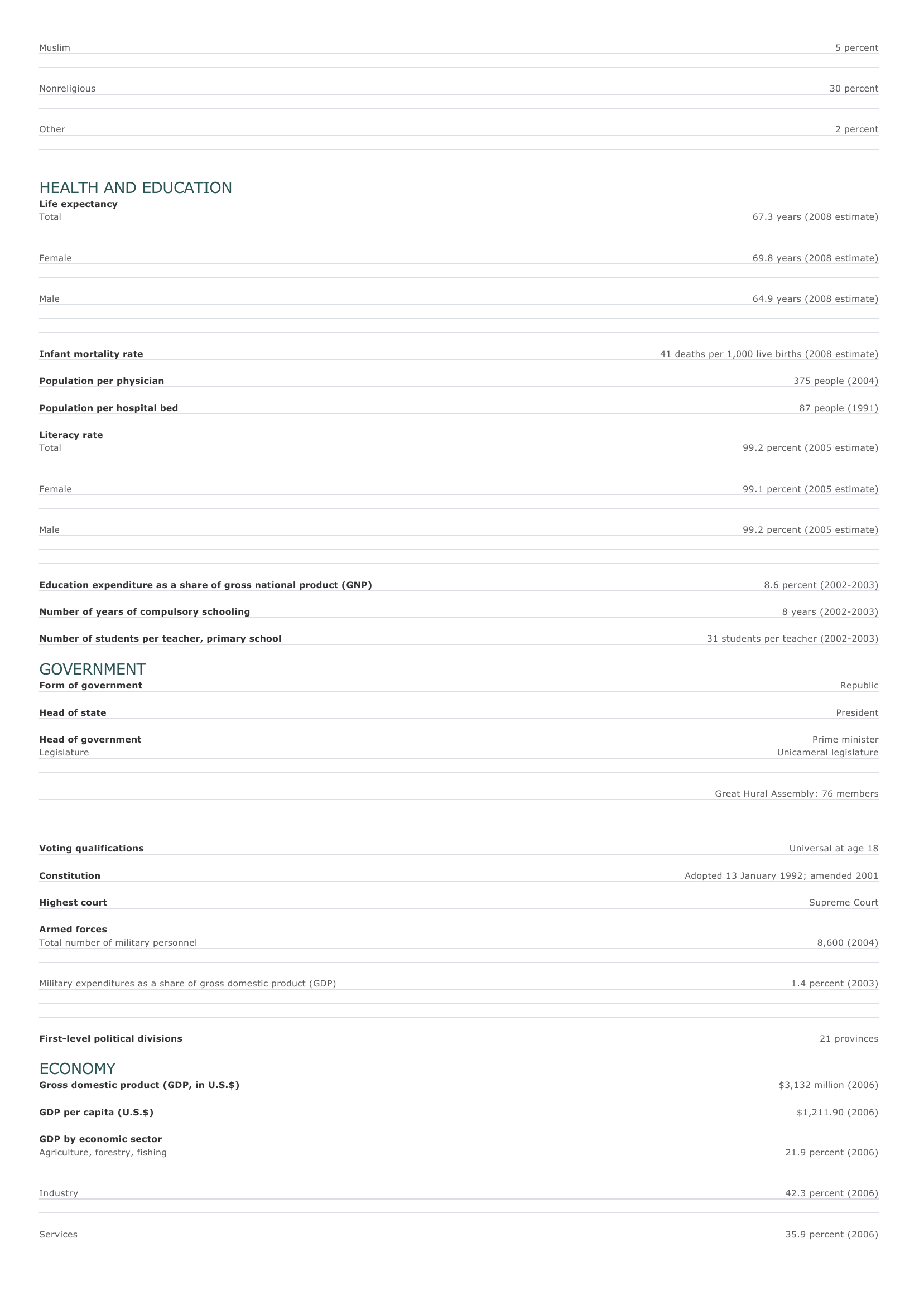Mongolia Facts and Figures. BASIC FACTS Official name Capital Area Mongolia Ulaanbaatar 1,566,500 sq km 604,830 sq mi PEOPLE Population 2,996,081 (2008 estimate) Population growth Population growth rate 1.49 percent (2008 estimate) Projected population in 2025 3,725,352 (2025 estimate) Projected population in 2050 4,340,496 (2050 estimate) Population density 1.9 persons per sq km (2008 estimate) 4.9 persons per sq mi (2008 estimate) Urban/rural distribution Share urban 57 percent (2005 estimate) Share rural 43 percent (2005 estimate) Largest cities, with population Ulaanbaatar 869,900 (2004 estimate) Darhan 71,400 (1999 estimate) Erdenetsogt 63,500 (1999 estimate) Choybalsan 41,700 (2001 estimate) Ethnic groups Mongol 90 percent K azakh 4 percent Chinese 2 percent Russian 2 percent O ther 2 percent Languages Khalkha Mongolian 90 percent Turkic, Russian, English, other Mongolian dialects 10 percent Religious affiliations Indigenous beliefs 31 percent Tibetan Buddhist (Lamaist) 23 percent Atheist 9 percent Muslim Nonreligious O ther 5 percent 30 percent 2 percent HEALTH AND EDUCATION Life expectancy Total 67.3 years (2008 estimate) Female 69.8 years (2008 estimate) Male 64.9 years (2008 estimate) Infant mortality rate Population per physician Population per hospital bed 41 deaths per 1,000 live births (2008 estimate) 375 people (2004) 87 people (1991) Literacy rate Total 99.2 percent (2005 estimate) Female 99.1 percent (2005 estimate) Male 99.2 percent (2005 estimate) Education expenditure as a share of gross national product (GNP) Number of years of compulsory schooling Number of students per teacher, primary school 8.6 percent (2002-2003) 8 years (2002-2003) 31 students per teacher (2002-2003) GOVERNMENT Form of government Head of state Head of government Legislature Republic President Prime minister Unicameral legislature Great Hural Assembly: 76 members Voting qualifications Constitution Highest court Universal at age 18 Adopted 13 January 1992; amended 2001 Supreme Court Armed forces Total number of military personnel Military expenditures as a share of gross domestic product (GDP) First-level political divisions 8,600 (2004) 1.4 percent (2003) 21 provinces ECONOMY Gross domestic product (GDP, in U.S.$) GDP per capita (U.S.$) $3,132 million (2006) $1,211.90 (2006) GDP by economic sector Agriculture, forestry, fishing 21.9 percent (2006) I ndustry 42.3 percent (2006) Services 35.9 percent (2006) Employment Number of workers 1,258,570 (2006) Workforce share of economic sector Agriculture, forestry, fishing 40 percent (2004) I ndustry 16 percent (2004) Services 44 percent (2004) Unemployment rate 14.2 percent (2003) National budget (U.S.$) Total revenue $392.4 million (2003) Total expenditure $482.4 million (2003) Monetary unit 1 tugrik (Tug), consisting of 100 mongo Major trade partners for exports China, United States, Russia, South Korea, and Italy Major trade partners for imports Russia, China, South Korea, Japan, and Germany ENERGY, COMMUNICATIONS, AND TRANSPORTATION Electricity production Electricity from thermal sources 100 percent (2003 estimate) Electricity from hydroelectric sources 0 percent (2003 estimate) Electricity from nuclear sources 0 percent (2003 estimate) Electricity from geothermal, solar, and wind sources 0 percent (2003 estimate) Number of radios per 1,000 people 142 (1997) Number of telephones per 1,000 people 61 (2005) Number of televisions per 1,000 people 58 (2000 estimate) Number of Internet hosts per 10,000 people 0.16 (2003) Daily newspaper circulation per 1,000 people 27 (1996) Number of motor vehicles per 1,000 people 41 (2002) Paved road as a share of total roads 4 percent (2002) SOURCES Basic Facts and People sections Area data are from the statistical bureaus of individual countries. Population, population growth rate, and population projections are from the United States Census Bureau, International Programs Center, International Data Base (IDB) (www.census.gov). Urban and rural population data are from the Food and Agriculture Organization (FAO) of the United Nations (UN), FAOSTAT database (www.fao.org). Largest cities population data and political divisions data are from the statistical bureaus of individual countries. Ethnic divisions and religion data are largely from the latest Central Intelligence Agency (CIA) World Factbook and from various country censuses and reports. Language data are largely from the Ethnologue, Languages of the World, Summer Institute of Linguistics International (www.sil.org). Health and Education section Life expectancy and infant mortality data are from the United States Census Bureau, International Programs Center, International database (IDB) (www.census.gov). Population per physician and population per hospital bed data are from the World Health Organization (WHO) (www.who.int). Education data are from the United Nations Educational, Scientific and Cultural Organization (UNESCO) database (www.unesco.org). Government section Government, independence, legislature, constitution, highest court, and voting qualifications data are largely from various government Web sites, the latest Europa World Yearbook, and the latest Central Intelligence Agency (CIA) World Factbook. The armed forces data is from Military Balance. Economy section Gross domestic product (GDP), GDP per capita, GDP by economic sectors, employment, and national budget data are from the World Bank database (www.worldbank.org). Monetary unit, agriculture, mining, manufacturing, exports, imports, and major trade partner information is from the statistical bureaus of individual countries, latest Europa World Yearbook, and various United Nations and International Monetary Fund (IMF) publications. Energy, Communication, and Transportation section Electricity information is from the Energy Information Administration (EIA) database (www.eia.doe.gov). Radio, telephone, television, and newspaper information is from the United Nations Educational, Scientific and Cultural Organization (UNESCO) database (www.unesco.org). Internet hosts, motor vehicles, and road data are from the World Bank database (www.worldbank.org). Note Figures may not total 100 percent due to rounding. Microsoft ® Encarta ® 2009. © 1993-2008 Microsoft Corporation. All rights reserved.


